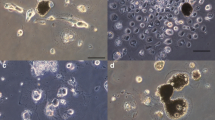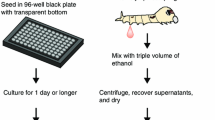Summary
An increasing number of polypeptide growth factors have been identified that have proven essential in the development of defined cell culture media for mammalian cell culture. The development of defined mammalian cell culture media, in turn, has provided an environment for studying cell lines in an experimentally manageable unit for studying the action of cellular regulators and genes that determine the properties of cells. Evidence that vertebrate growth factors may be present in insects is based on DNA sequences that encode epidermal growth factor and transforming growth factor-β. However, research on the influence of commercially available vertebrate growth factors is very limited. Although the majority of insect growth-promoting substances studied were isolated directly from insect hemolymph, few of these have been purified to the extent that they could be tested in insect cell, tissue, and endoparasite cultures. Research is needed in both of these areas to aid in developing defined insect culture systems, and to understand better the regulation of postembryonic growth and development in insects.
Similar content being viewed by others
References
Aizawa, K.; Sato, F. Culture de tissus de ver a soie,Bombyx mori, dans un milieu sans hemolymphe. Ann. Epiphyt. 14:125; 1963.
Barnes, D.; Sato, G. Serum-free cell culture: a unifying approach. Cell 22:649–655; 1980.
Barnes, D.; Sirbasku, editors. Peptide growth factors, Methods in Enzymology, vols. 146, 147. New York: Acedemic Press; 1987.
Baxter, R. C.; Martin, J. L. Binding proteins for the insulin-like growth factors: structure, regulation and function. Prog. Growth Factor Res. 1:49–68; 1989.
Bryant, P. J. Localized cell death caused by mutations in aDrosophila gene coding for a transforming growth factor-β homolog. Dev. Biol. 128:386–395; 1988.
Chiu, R.-J.; Black, L. M. Monolayer cultures of insect cell lines and their inoculation with a plant virus. Nature 215:1076–1078; 1967.
Davis, K. T.; Shearn, A. In vitro growth of imaginal disks fromDrosophila melanogaster. Science 196:438–440; 1977.
Deul, T. F. Polypeptide growth factors: roles in normal and abnormal cell growth. Ann. Rev. Cell Biol. 3:443–492; 1987.
Ebberink, R. H. M.; Smit, A. B.; Van Minnen, J. The insulin family: evolution of structure and function in vertebrates and invertebrates. Biol. Bull. 177:176–182; 1989.
Ferkovich, S. M.; Oberlander, H.; Dillard, C., et al. Purification and properties of a factor from insect hemolymph that promotes multicellular vesicle formation in vitro. Arch. Insect Biochem. Physiol. 6:73–83; 1987.
Ferkovich, S. M.; Oberlander, H.; Dillard, C., et al. Identification of a cell line vesicle promoting factor in larval tissues ofTrichoplusia ni. In: Hagedorn, H. H.; Hildebrand, J. G.; Kidwell, M. G., et al., eds. Molecular insect science. New York and London: Plenum Press; 1990:301.
Garcia, J. V.; Gehm, B. D.; Rosner, M. R. An evolutionarily conserved enzyme degrades transforming growth factor-alpha as well as insulin. J. Cell Biol. 109:1301–1307; 1989.
Goodwin, R. H.; Adams, J. R. Nutrient factors influencing viral replication in serum-free insect cell line culture. In: Kurstack, E.; Maramorosh, K.; Dubendorfer, A., eds. Invertebr. systems in vitro. 16:493-509; 1980.
Gospodarowicz, D.; Moran, J. S. Growth factors in mammalian cell culture. Ann. Rev. Biochem. 45:531–558; 1976.
Grace, T. D. C. Establishment of four strains of cells from insect tissue grownin vitro. Nature 195:788–789; 1962.
Greany, P.; Clark, W.; Ferkovich, S. M., et al. Isolation and characterization of a host hemolymph protein required for development of the eggs of the endoparasiteMicroplitis croceipes. In: Hagedorn, H. H.; Hildebrand, J. G.; Kidwell, M. G., et al., eds. Molecular insect science. New York and London; Plenum Press; 1990:306.
Greany, P. D.; Ferkovich, S. M.; Hanrahan, A. M. Use of dialyzed, concentrated fetal bovine serum as a medium supplement for the endoparasitoidApanteles marginiventris (Cresson). VI International Conference on Invertebrate Tissue Culture. Abstracts, E. Kurstak, University of Montreal, Canada. 1983:78.
Heath, J. K. Progress in growth factor research editorial. Prog. Growth Factor Res. 1:i-ii; 1989.
Hsu, S. H.; Liu, H. H.; Suitor, E. C., Jr. Further description of a subline of Grace’s mosquito (Aedes aegypti L.) cells adapted to hemolymph-free medium. Mosq. News 29:439–446; 1969.
Hubners, H. A.; Hubners, E.; Webb, B. A., et al. Iron binding proteins and their roles in the tobacco hornworm,Manduca sexta (L.). J. Comp. Physiol. B158:291–300; 1988.
Irie, K.; Xie, Z.; Nettles, W. C., Jr., et al. The partial purification of a Trichogramma pretiosum pupation factor from hemolymph ofManduca sexta. Insect Biochem. 17:269–275; 1987.
Kanost, M. R.; Kawooya, J. K.; Law, J. H., et al. Insect haemolymph proteins. Adv. Insect Physiol. 22:299–396; 1990.
Kaufmann, U.; Zapf, J.; Torretti, B., et al. Demonstration of a specific carrier protein of nonsuppressible insulin-like activityin vivo. J. Clin. Endocrinol. Metab. 44:160–166; 1977.
Kelley, M. R.; Kidd, S.; Deutsch, W. A., et al. Mutations altering the structure of epidermal growth factor-like coding sequences at theDrosophila notch locus. Cell 51:539–548; 1987.
Kopczynski, C. C.; Alton, A. K.; Fechtel, K., et al. Delta,Drosophila neurogenic gene, is transcriptionally complex and encodes a protein related to blood coagulation factors and epidermal growth factor of vertebrates. Genes Dev. 2:1723–1735; 1988.
Kuno, G.; Hink, W. F.; Briggs, J. D.; Growth-promoting serum proteins forAedes aegypti cells cultured in vitro. J. Insect Physiol. 17:1865–1879; 1971.
Lynn, D. E.; Oberlander, H. Obtainment of hormonally sensitive cell lines from imaginal discs of Lepidoptera species. In: Techniques in in vitro invertebrate hormones and genes. Techniques in the life sciences; cell biology, vol. C2. Ireland: Elsevier Scientific Publishers; 1986:1–12.
Lynn, D. E.; Hung, A. C. F. Development of a continuous cell line from the insect egg parasitoid,Trichogramma pretiosum (Hymenoptera: Trichogrammatidae). In Vitro Cell. Dev. Biol. 22:440–442. 1986.
McKeehan, W. L.; Barnes, D.; Reid, L., et al. Frontiers in mammalian cell culture. In Vitro Cell. Dev. Biol. 26:9–23; 1990.
Mitsuhashi, J. Nutritional requirements of insect cellin vitro. In: Mitsuhashi, J., ed. Invertebrate cell system applications. Boca Raton, FL: CRC Press; 1989:3–20.
Mitsuhashi, J.; Goodwin, R. H. The serum-free culture of insect cellsin vitro. In: Mitsuhashi, J., ed. Invertebrate cell system applications. Boca Raton, FL:CRC Press; 1989:31–43.
Oberlander, H. Growth and partial metamorphosis of imaginal disks of the greater wax moth,Galleria mellonella, In vitro. Nature 216:1140–1141; 1967.
Padgett, R. W.; St. Johnson, R. D.; Gelbart, W. M. A transcript from aDrosophila pattern gene predicts a protein homologous to the transforming growth factor-B family. Nature 325:81–84; 1987.
Seecof, R. L.; Dewhurst, S. Insulin is aDrosophila hormone and acts to enhance the differentiation of embryonicDrosophila cells. Cell Differ. 3:63–70; 1974.
Vaughn, J. L.; Louloudes, S. J. Isolation of two growth promoting fractions from insect hemolymph. In Vitro 14:351; 1978.
Wharton, K. A.; Johansen, K. M.; Xu, T., et al. Nucleotide sequence from the neurogenic locus Notch implies a gene product that shares homology with proteins containing EGF-like repeats. Cell 43:567–581; 1985.
Wielgus, J. J.; Caldwell, G. A.; Nichols, R. L., et al. Purification, properties, and titer of a hemolymph trophic factor in larvae and pupae ofManduca sexta. Insect Biochem. 20:65–72; 1990.
Williams, C. M.; Kambysellis, M. P. In vitro action of ecdysone. Proc. Natl. Acad. Sci. USA 63:231; 1969.
Wyss, C. CalGF, a cationic low molecular weight growth factor fromDrosophila melanogaster and the nutritional requirements of kchp cells. Insect Biochem. 12:515–522; 1982.
Yunker, C. E.; Vaughn, J. L.; Cory, J. Adaptation of an insect cell line (Grace’s Antheria cells) to medium free of insect hemolymph. Science 155:1565–1566; 1967.
Author information
Authors and Affiliations
Rights and permissions
About this article
Cite this article
Ferkovich, S.M., Oberlander, H. Growth factors in invertebrate in vitro culture. In Vitro Cell Dev Biol - Animal 27, 483–486 (1991). https://doi.org/10.1007/BF02631149
Received:
Accepted:
Issue Date:
DOI: https://doi.org/10.1007/BF02631149




